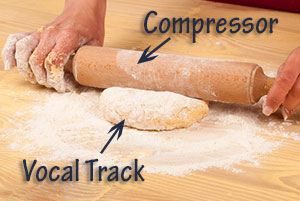 For years I’ve been following the common and age-old advice for vocal compression, which is to start at about a 3:1 ratio, using a fast attack time (like 0-to-10 millseconds so little-to-none of the vocal is heard above the threshold), and medium slow release time (50-to-80 milliseconds so the notes decay naturally). Then set the threshold to -20 dB. You’ll then need to adjust the threshold setting until only the loudest notes are being reduced, and that reduction should not be much more than about 3 dB. Then just use your ears to make adjustments until you get things just right. To review what the heck I’m talking about with all these settings, see my video post Vocal Compression Using Reaper’s ReaComp Effect .
For years I’ve been following the common and age-old advice for vocal compression, which is to start at about a 3:1 ratio, using a fast attack time (like 0-to-10 millseconds so little-to-none of the vocal is heard above the threshold), and medium slow release time (50-to-80 milliseconds so the notes decay naturally). Then set the threshold to -20 dB. You’ll then need to adjust the threshold setting until only the loudest notes are being reduced, and that reduction should not be much more than about 3 dB. Then just use your ears to make adjustments until you get things just right. To review what the heck I’m talking about with all these settings, see my video post Vocal Compression Using Reaper’s ReaComp Effect .
But as with all things audio, you should use your ears to determine what is “right.” Still though, it’s hard to stray too far from what you’ve been taught is the “normal” way of doing things. I just re-watched a video (see my post An Interesting Vocal Compression Tip) that I wrote about here a few months ago that suggests a bit of a different approach to vocal compression. At the time, I sort of thought it was interesting and suggested you might want to try it out. However, I did not take my own advice! Now I have, though. And I have a new normal.
In the video, Andrew Koss explains his technique of using super fast attack AND release times (like zero on both), with a very low ratio (try 1.5:1 or 2:1), and gain reduction of -10 or -12 dB. I tried it and really like the way it makes my vocals sound.
One thing to be careful of, though, is sibilance (that enhanced SSSSSS sound) being hyped, which can happen on some compressors (or compressor plugins) when extreme settings are selected. If you REALLY like the added pop in the voice that this technique gives you, and you get a bit of excess sibilance, you can always use EQ to reduce it. See our article – How to Fix SSS-Sibilance in Your Audio With Sound Editing Software.
Try it and see what you think!
Cheers,
Ken
Focus Control On The Blue Spark Microphones
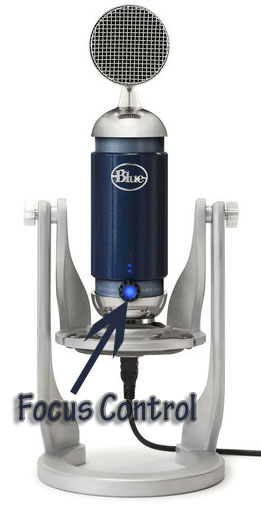 Blue, an awesome microphone company, recently [this post was written in 2013] released a condenser microphone called the Blue Spark. Very shortly thereafter, Blue released the Blue Spark Digital, which (according to Blue) is the first studio condenser microphone that you can use as both a USB mic AND an iPad mic. The Apogee MiC can do this also, but the USB mode only works with Macs!
Blue, an awesome microphone company, recently [this post was written in 2013] released a condenser microphone called the Blue Spark. Very shortly thereafter, Blue released the Blue Spark Digital, which (according to Blue) is the first studio condenser microphone that you can use as both a USB mic AND an iPad mic. The Apogee MiC can do this also, but the USB mode only works with Macs!
Anyway, both models of the Blue Spark mic come with something called “Focus Control,” which is a button that creates two different types of sound, depending on whether it is activated (pushed in) or not.
Now at first blush, this sounded to me like a simple pad switch, which is common on a lot of different condenser mics. All a pad switch does is reduce (attenuate) audio below a target frequency.
Blue describes Focus control when in the “off” position (button sticking out) as providing an “enhanced low end.” They say you can get the “big radio voice” in this mode, so voice-over folks pay heed. Then when you decide you want a “more present” sound, you push the Focus Control Button in. This provides “greater clarity and detail.”
However, Blue says this is different from standard attenuator “pad” switches because it doesn’t treat the mic’s signal output, but instead changes the input driver, essentially creating an entirely different microphone in a way. When an attenuator is applied to the output signal, as in the case of those pad switches, the quality of the signal can be degraded based on the quality of the mechanism on the mic. But by changing the input driver by “altering the voltage loading of the capsule,” you get a change in the behavior of the capsule that is more nuanced.
I very much wish I had one of these mics here (hey, I can’t buy every mic out there – sadly) [update Sep 2016 – I DID manage to get my hands on one for review. And the result is here: My Review Of The Blue Spark Digital USB And iOS Microphone. You can listen to several audio tests, including the focus control, to hear what that does.
Some Live Sound Tips That Are Not About Sound
I was just reading an article aimed at live-gig engineers, the folks behind the mixing board at live music shows. There are some really good tips there and if you do live PA stuff, you should check it out. But one thing I took away from it applies to folks doing recording as well.
The not-so-obvious stuff is often the most important. And the one I have been thinking about a lot is that it does not matter if you know how to work the controls inside of Reaper, or Audacity, or Pro Tools, etc. Anyone can be taught how to pan and manipulate the mixing sliders on a track, or how to add effects to a track. But that is what we are trying to teach! We are trying to teach you how to produce great-sounding audio. For that you need to know WHY to do certain things, not just how. The how is usually pretty easy.
For example, if you know why to use a compression effect, and what can happen if you overdo it, then you can do it no matter what program you use. The Same thing for EQ. Once you understand the principles behind these effects and controls, then you can take that knowledge anywhere, even into the live sound world. All you may need is for someone to tell you where the particular controls and effects are when you move to a new program, or even to hardware. And that is super easy.
Anyway, here is the original article I referred to focusing on the not-so-obvious things in live sound work – http://www.prosoundweb.com/article/not_so_obvious_its_about_more_than_sound/P2/
Microphone Used By Chair Umpire At US Open Tennis Tournament
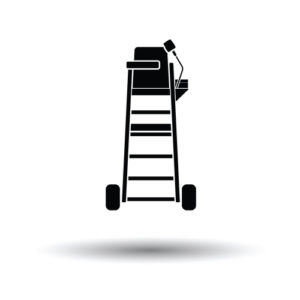
This was originally written while I was watching the 2012 US Open Tennis tournament. But I thought I’d go ahead and post it here because we’re currently watching the 2013 French Open, and I was reminded of these mics used by chair umpires. Keep an eye out for them again at the 2013 US Open [UPDATE – Yup, they made their appearance again for the 2013 US Open. though I haven’t seen them since then.]
I was going crazy trying to figure out what that large (huge really) microphone was that the chair umpires were using during the 2012 US Open Tennis Tournament. And no wonder I couldn’t find an answer – it isn’t a large mic at all! It’s a cover for the mic (any mic) called the Rycote Baby Ball Gag Windshield (yeah, sounds like something kinkier than a microphone attachment;)).
The Baby Ball Gag Windshield actually covers the capsule of a microphone to reduce the effect of wind blowing across it. The ball-shaped cover actually comes in two parts so if you need to cover a standard ball-end microphone like a Shure SM58, you can, though it is really designed for cylindrical mics like the Sennheiser MKH 416 shotgun mic.
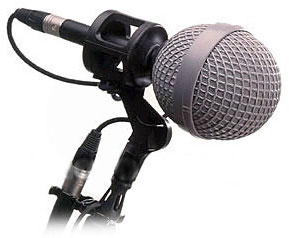
The inside of the Ball Gag is made of the same kind of materials as the full-sized modular wind shields.
Thanks goodness I finally figure this out. I must have typed “what kind of microphone is used by tennis umpires?” a hundred times before finally looking at windshield attachments rather than the mic itself. Yay! If you have been wondering like I was, here’s your answer. Also, if you need to get one of these for your own outdoor microphone needs, you can get one for yourself. Just click here.
Victoria Azarenka Wears Powerbeats by Dr. Dre In-Ear Headphones
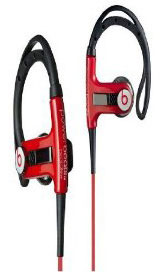 Victoria Azarneka, in action a few weeks ago, at the French Open, wears Powerbeats by Dr. Dre before all her tennis matches. I first noticed this before the 2012 US Open Tennis Championship match, when they always show the players inside just before their pre-match interview. I’m expecting that she will do the same today [this is an update to the post as of Sep 8th, 2013] in her fina (once again) with Serena Williams (once again). I’ve seen her with these a few more times since then with the same Powerbeats hook-over-the-ear type of in-ear headphones. Here is what I wrote at the time by way of description of these Powerbeats.
Victoria Azarneka, in action a few weeks ago, at the French Open, wears Powerbeats by Dr. Dre before all her tennis matches. I first noticed this before the 2012 US Open Tennis Championship match, when they always show the players inside just before their pre-match interview. I’m expecting that she will do the same today [this is an update to the post as of Sep 8th, 2013] in her fina (once again) with Serena Williams (once again). I’ve seen her with these a few more times since then with the same Powerbeats hook-over-the-ear type of in-ear headphones. Here is what I wrote at the time by way of description of these Powerbeats.
Add Victoria Azarenka to the list of athletes who wear Dr. Dre headphones. At the 2012 US Open, it was very clear to see that she was wearing Powerbeats by Dr. Dre In-Ear Headphones during her pre-match interview for both the semi-finals on Friday and the finals on Sunday. The thing that is different about these though, is that they are more like ear buds than headphones. I really like this type of headphone because they allow you to go jogging without falling out of your ears like regular ear buds. And it would be pretty awkward to jog with full-on headphones.
The Powerbeats provide the same great audio quality as the full-sized headphones in the Dr. Dre line, the Beats by Dr. Dre. Plus unlike most ear bud type phones, these offer ControlTalk for on-cable iPod/iPhone control.
To find out more or buy a pair, click here.